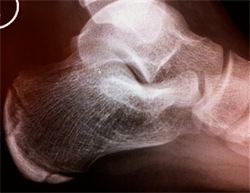Sever's Heel or Calcaneal Apophysitis (Children's Heel Pain)
Heel pain, unlike the Plantar Fasciitis pain, that occurs in adults is very uncommon in children. Of those children who do suffer, by far the most common cause is a disturbance to the growing area at the back of the heel bone (calcaneus) where the strong achilles tendon attaches to it. This is known as Sever's Disease or Calcaneal Apophysitis (inflammation of the growth plate).
It is most common between the age of 9 to 14. These are one of several different 'osteochondroses' that can occur in other parts of the body, such as at the knee (Osgood-Schlatters Disease).
The anatomy of heel pain in the child
When a baby is born, most of the bones are still cartilage with only some starting to develop into bone. When the heel (calcaneus) starts to develop bone, there is generally one large area of development that starts in the center of the cartilage heel. This area of bone spreads to 'fill up' the cartilage.

Another area of bone development (ossification) occurs at the back of the heel bone - see the x-ray below. These two areas of developing bone will have an area of cartilage between them - this is how the bone grows in size. At around age 16, when growth is nearly complete, these two bony areas fuse together. Sever's Disease or Calcaneal Apophysitis is usually considered to be due to damage or a disturbance in this area of growth.
The two growth areas of the calcaneus can be seen on this x-ray.
The smaller area to the back of the heel is normal. Notice the small cartilage joint between the two.
What are the symptoms of heel pain in the child?
Pain is usually felt at the back and side of the heel bone. Sometimes there may be pain at the bottom of the heel. The pain is usually relieved when the child is not active and becomes painful with sport. Squeezing the sides of the heel bone is often painful. Running and jumping make the symptoms worse. One or both heels can be affected. In more severe cases, the child may be limping.
What causes heel pain in children?
The cause of Sever's Disease is not entirely clear. It is most likely due to overuse or repeated minor trauma that happens in a lot of sporting activities - the cartilage join between the two parts of the bone can not take the stress of the activities. Some children seem to be just more prone to it for an unknown reason - combine this with sport, especially if its on a hard surface and the risk of getting it increases. It can be almost epidemic at the start of some sports seasons, especially winter. At the start of winter, the grounds are often harder, but soften later. Children who are heavier are also at greater risk of developing Calcaneal Apophysitis.
A tight calf muscle is also common in those who develop Calcaneal Apophysitis - if you look at the x-ray above, you can imagine how much pull there is from the calf muscles via the achilles tendon on the small growth plate at the back and the strain that this will place on the cartilage join between them. A pronated (a foot rolled in at the ankle) is also more common - it is assumed that this may cause an uneven weight bearing on the back part of the heel bone.

